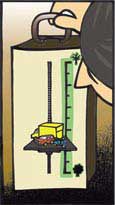Driven for and by the people
 I n the past few decades, society has played a proactive role in purging the market of toxic products. This has been largely possible due to sustained information campaigns, highlighting the damage these noxious substances cause to the environment and health. Cases in point are public disclosure drives that have led to the banning of ddt (dichlorodiphenyl trichloro-ethane) and intermediate dyes, and forced the paper industry to consider chlorine-free bleaching.
I n the past few decades, society has played a proactive role in purging the market of toxic products. This has been largely possible due to sustained information campaigns, highlighting the damage these noxious substances cause to the environment and health. Cases in point are public disclosure drives that have led to the banning of ddt (dichlorodiphenyl trichloro-ethane) and intermediate dyes, and forced the paper industry to consider chlorine-free bleaching.
The foundation for the Green Rating Project (grp), too, is laid on public participation
Related Content
- World health statistics 2025: Monitoring health for the SDGs, Sustainable Development Goals
- Asian Development Outlook- April 2025
- From millions to billions: financing the development of African cities
- Engaging young people in Asia and the Pacific’s water and sanitation management
- Children displaced in a changing climate
- Water, ice, society, and ecosystems in the Hindu Kush Himalaya: an outlook
